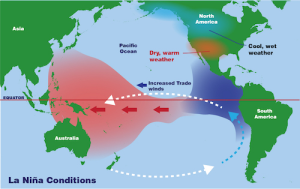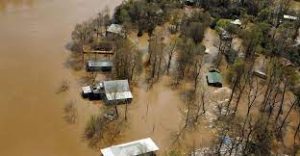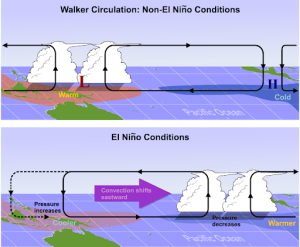15 Sep “Triple Dip” La Nina
La Nina and El Nino
The occurrence of the La Nina phenomenon for the third consecutive year in the Pacific Ocean, confirmed by The Australian Bureau of Meteorology
For the very first time in this century, spanning three consecutive northern hemisphere winters to become a ‘triple dip’ La Nina, stated by The World Meteorological Organization (WMO) on August 31.
Paper:GS-I: Geography (Climatology, Important Geophysical Phenomena), GS-III: Environment and Ecology (Environmental Pollution and Degradation, Impact of Climate Change)
What are La Nina and El Nino?
- El- Nino which means “the boy” and La – Nina which means “the girl” in Spanish are two mutually opposite phenomena.
- During the occurrence of this phenomenon, an abnormal rise or cooling of sea surface temperatures is observed in the Pacific Ocean along the equator, off the coast of South America.
- Together they constitute, called as El Niño-Southern Oscillation system, or ENSO
- The impact of ENSO conditions can affect both temperatures and rainfall globally, due to their strong interference with global atmospheric circulations.
- Usually, it has been seen that El Nino and La Nina occur every four to five years.
- El Nino is more frequent than La Nina.
- Neutral: These years are not associated with any of the above phenomena.

Pic: La Nina
La Nina

Pic: la nina weather
- La Nina is a complex weather pattern that occurs in an interval of 4 to 5 years, as a consequence of variations in ocean temperatures in the Equatorial Pacific.
- It is a coupled ocean-atmosphere occurrence, which is the colder counterpart of El Niño, as part of the broader EL Nina–Southern Oscillation (ENSO) climate pattern.
- An appearance of it can continue for at least 5 months.
- During a period of it, the sea surface temperature over the equatorial Eastern Central Pacific Ocean will be lower than normal by 3 to 5 °C.
- An appearance of it persists for at least five months.
- It has extensive effects on global weather, particularly in North America, even affecting the Atlantic and Pacific hurricane seasons, in which more tropical cyclones occur in the Atlantic basin due to low wind shear and warmer sea surface temperatures, while reducing tropical cyclogenesis in the Pacific Ocean.
- It comes out as strong winds blow warm water at the ocean’s surface from South America across the Pacific Ocean towards Indonesia.
- As this warm water moves towards the west, cold water from the deep sea rises to the surface near South America.
- Consequently, it is considered to be the cold phase of the broader El Nino–Southern Oscillation weather pattern and the opposite of the El Niño weather pattern.
- It impacts the global climate and disrupts normal weather patterns, which as a result can lead to intense storms in some places and droughts in others.
El-Nino
- The warming phase of the sea temperature is known as El Nino and is linked to a band of warm ocean water that evolves in the central and east-central equatorial Pacific, including the area off the Pacific coast of South America.
- El Nino is accompanied by high air pressure in the western Pacific and low air pressure in the eastern Pacific.
- During the evolution of El Nino, rain falls between September–November.
ENSO
- El Nino and the Southern Oscillation, also known as ENSO, is a periodic disturbance in sea surface temperature (El Niño) and the air pressure of the overlying atmosphere (Southern Oscillation) across the equatorial Pacific Ocean.
- The ENSO is the cycle of warm and cold sea surface temperature (SST) of the tropical central and eastern Pacific oceans.
- The cool phase of ENSO is La Niña, with SSTs in the eastern Pacific below average, and air pressure high in the eastern Pacific and low in the western Pacific.
- The ENSO cycle, including El Niño and La-Niña, causes global changes in temperature and rainfall.

Pic: El-Nino
Impact of ENSO on the Indian Subcontinent
- Weather:
- El-Nino causes temperature rise and reduces rainfall over the Indian subcontinent, during the monsoon season. On the other hand, la-Nina brings rainfall and decreases the temperature. Hence, this is why it is heartily welcomed in the Indian subcontinent.
- Environmental Disasters like Drought and Floods:
- Although El Nino leads to drought events in the subcontinent, La Nina is primarily associated with flood events. These disasters affect the socioeconomic status of the affected countries.
- Health:
- El Nino brings droughts to lead to forest fires, and wildfires, thus aggravating respiratory causes by air pollution. While, La-Nina brings flooding, as well as water-borne diseases like Cholera, Malaria, Jaundice, etc.
- Irrigation:
- The irrigated area accounts for 48.8% of the total agricultural area of the country. The remaining 51.2% is rainfed. This rainfed area is primarily dependent upon monsoonal rains. Therefore, the El-Nino-induced rainfall-deficit year brings worries for Indian farmers, while La-Nina induced surplus year is widely welcomed by Indian farmers.
- Economy:
- As Indian agriculture primarily depends upon the monsoons, also the fact that India is a primarily agricultural country, impacts the Indian economy.
- ENSO affects the Indian economy in a major way. Better agricultural output means better returns for the Indian farmers and rural population. This induces demand and raises the economic output of the country. Since the ENSO impacts farmers and rural poor more, it also has an important role in the reduction or exacerbation of inequality in the country.
- Ecosystem: ENSO causes warmer and colder temperatures in the sea surface waters. Since the corals are a delicate ecosystem, the temperature change potentially affects their ecosystem.
Why have La Nina conditions continued for 3 years?
- This behavior is termed “abnormal “by the scientist.
- It is surprising that it has continued for the last three years. It may be good for India but not for some other countries.
- Under climate change conditions, one must expect more such instances. Climate change could be a factor driving such anomalous conditions.
Sources:
- TheIndianExpress (‘Triple dip’ La Nina and its impact on India’s monsoon)
Download Now:
Plutus IAS current affairs eng med 15th Sep 2022
IAS Current Affairs
Every UPSC aspirant wants to get good marks on the UPSC examination and secure a high rank in their exam. If any UPSC aspirant wants to become an IAS officer, he/she has to secure a high rank in the UPSC examination. For getting good marks, any aspirant should increase their general knowledge. If any examinee wants to increase their general knowledge, he/she should read current affairs every day. So for becoming an IAS officer, Current affairs play an important role. So get the best and latest daily, weekly and monthly current affairs for the UPSC examination from Plutus IAS.




No Comments